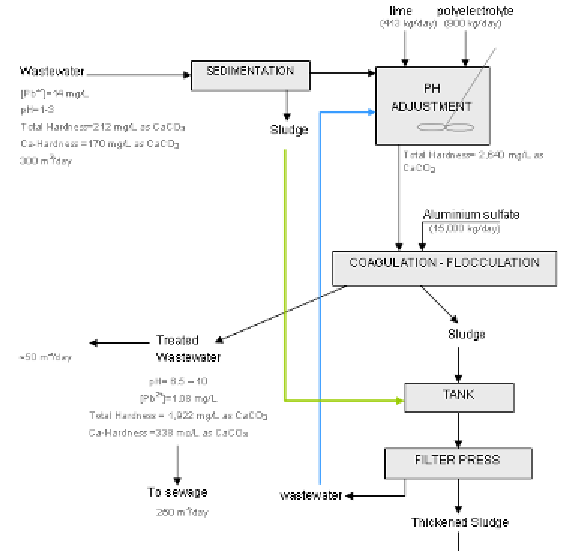Environmental Engineering Reference
In-Depth Information
Modification of the Wastewater
Treatment Facility to Reduce
the Amounts of Chemicals
Used and to Decrease Water
Consumption in Production
natant) is then transferred to pH adjustment unit
in which lime (CaO) is added (413 kg/day) to
raise pH value of the wastewater from 1.3 to 8.5-
9.0. The addition of polyelectrolyte, which is a
polymer used to stabilize the sludge, is also ac-
complished in this unit (900 kg/day). Following
up the pH adjustment, aluminum sulfate
(Al
2
(SO
4
)
3
) is added as precipitant for the re-
moval of Pb dissolved in wastewater in coagula-
tion and flocculation unit. The sludge formed in
this reactor is sent to sludge collection tank and
then to filter press to become thicker. The waste-
water from the filter press unit is recycled back
to mixing process. The sludge is sent to the recy-
cling facility since it contains considerable amount
of lead. The wastewater from flocculation unit is
discharged to sewage while about 1/6
th
of the
volumetric flow is reused as lead suppressant and
in negative drying purposes. Since the hardness
of the treated wastewater is high enough to stain
The cooling and washing water coming from wet-
charging process, the charging water of plates and
the water used in cleaning equipments are collected
and then treated in the wastewater treatment facil-
ity operated by the company. Figure 2 shows the
unit operations and processes in the wastewater
treatment facility of the company.
As shown in Figure 2, the collected wastewa-
ter from the resources mentioned above, with a
discharge of 300 m
3
/day, is first transferred to
sedimentation tank to remove particles, which
have high amount of Pb. The sludge formed in
this process is sent to the tank used for the col-
lection of sludge. The cleared wastewater (super-
Figure 2. Operations in the wastewater treatment facility

